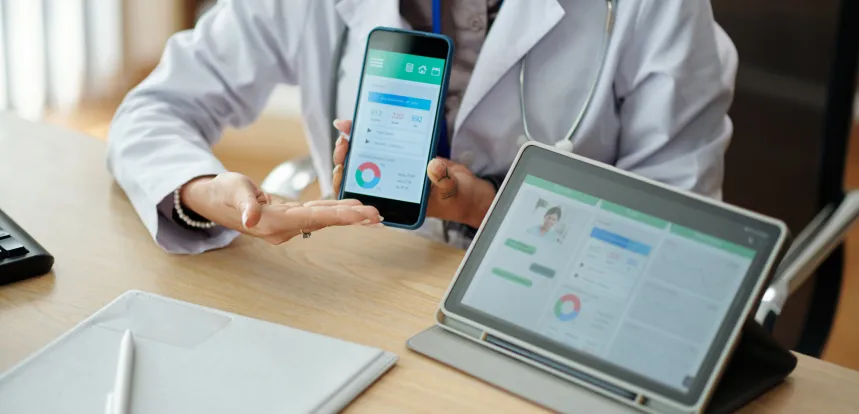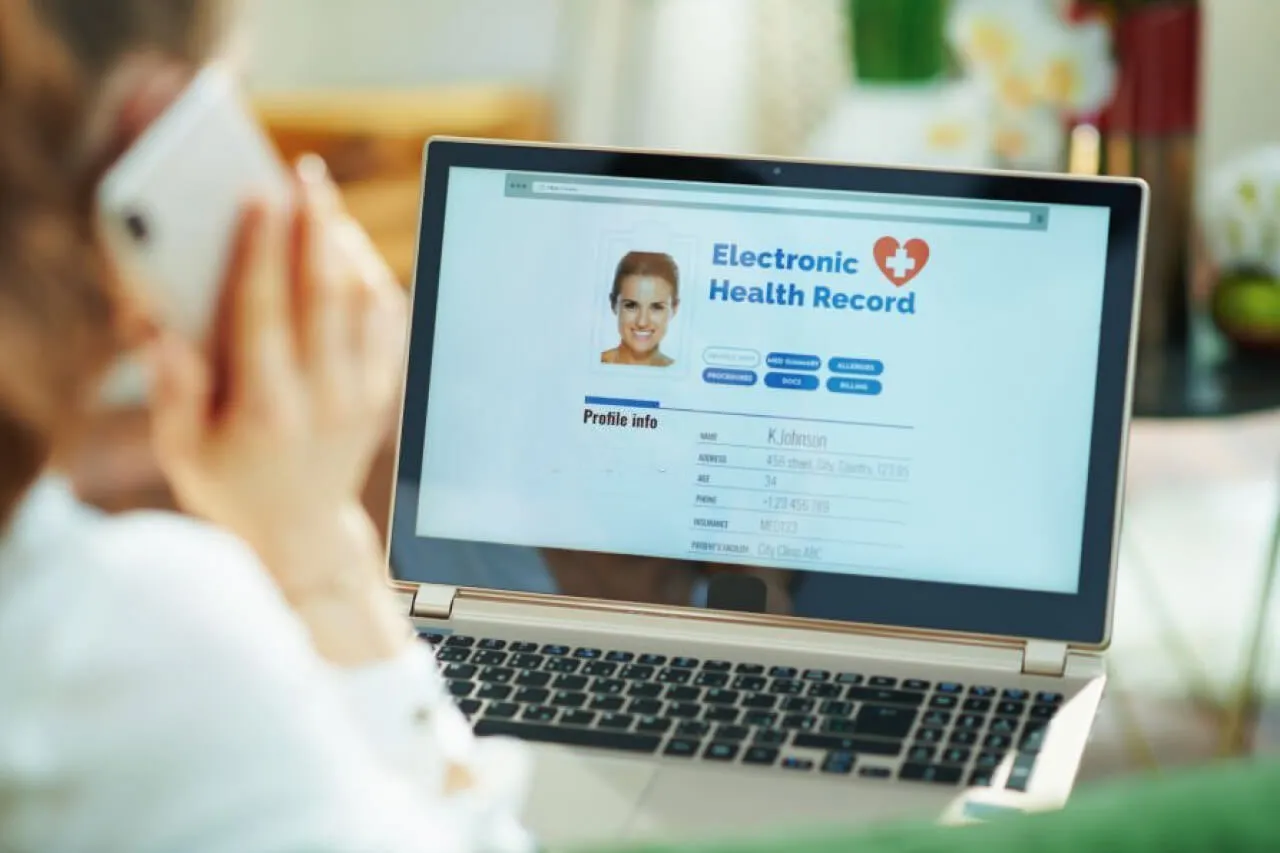Explain EHR Software and its Importance
An Electronic Health Record (EHR) system is a digitalized platform that facilitates the secure storage, management, and exchange of patient health information across various healthcare providers, facilities, and platforms. It encompasses comprehensive patient data, including medical history, diagnoses, medications, treatment plans, and test results.

The significance of EHR systems lies in their ability to enhance patient care, improve medical workflows, and promote informed decision-making by enabling real-time access to accurate and up-to-date patient information. They streamline communication among healthcare professionals, reduce paperwork, minimize errors, support data analysis for better outcomes, and contribute to healthcare services’ overall efficiency and quality.
Key Challenges and Issues with EHR System
While Electronic Health Record (EHR) systems offer numerous benefits, they also present certain challenges and issues that healthcare organizations need to address:
- Interoperability: EHR systems from different vendors might not seamlessly communicate, hindering the exchange of patient data between various healthcare facilities and providers.
- Data Privacy and Security: Safeguarding patient data is crucial, but EHR system development can be vulnerable to breaches, unauthorized access, and hacking, potentially compromising sensitive health information.
- User Adoption: Transitioning from paper-based to electronic records can face resistance from staff who need to adapt to new technology and workflows, affecting user adoption rates.
- Workflow Disruption: Implementing EHR systems can temporarily disrupt established workflows, leading to potential delays and inefficiencies during the adjustment period.
- Data Entry and User Experience: Cumbersome data entry processes and complex user interfaces can lead to data inaccuracies and frustration among healthcare professionals.
- Technical Challenges: Technical glitches, system downtime, and compatibility issues can disrupt access to patient information, affecting patient care.
- Cost and Resources: EHR implementation requires significant financial investments, including software, hardware, training, and ongoing maintenance costs.
- Regulatory Compliance: EHR systems must adhere to various healthcare regulations, standards, and privacy laws, which can be challenging to manage consistently.
- User Training: Proper training is crucial for utilizing EHR systems effectively, and inadequate training can lead to errors, inefficiencies, and decreased user satisfaction.
- Usability Concerns: If EHR systems are not designed with user experience in mind, healthcare professionals might struggle to navigate and use the software efficiently.
- Data Overload: EHR systems can generate vast amounts of data, potentially overwhelming healthcare providers and obscuring critical information.
- Patient Data Accuracy: Inaccurate or incomplete data entry can lead to errors in patient records, potentially affecting diagnoses, treatments, and care plans.
Ways through which EHR Improves Patient Care
Electronic Health Record (EHR) systems significantly enhance patient care through various ways:
- Comprehensive Patient Information: EHRs consolidate a patient’s medical history, diagnoses, medications, allergies, and test results in one accessible record, empowering healthcare providers with a holistic view of the patient’s health status.
- Real-Time Data Access: EHRs enable healthcare professionals to access up-to-date patient information promptly, leading to quicker diagnosis, treatment decisions, and interventions.
- Coordination of Care: EHRs facilitate seamless communication among healthcare providers, specialists, and facilities, ensuring coordinated care and reducing the risk of duplicative or conflicting treatments.
- Personalized Treatment Plans: EHRs support the creation of personalized treatment plans based on a patient’s history and specific needs, leading to more targeted and effective interventions.
- Medication Safety: EHRs help prevent medication errors by providing accurate drug information, potential interactions, and allergies, leading to safer prescription practices.
- Clinical Decision Support: EHRs offer tools that provide healthcare professionals with evidence-based guidelines and alerts, guiding them toward best practices and informed decisions.
- Remote Monitoring: EHRs can integrate with remote monitoring devices to track patients’ vital signs and conditions remotely, enabling timely interventions and reducing hospitalizations.
- Patient Engagement: EHRs often include patient portals that empower individuals to access their health records, lab results, and appointment schedules and communicate with their healthcare providers, promoting engagement and self-management.
- Preventive Care: EHRs support reminders for preventive screenings, vaccinations, and follow-up appointments, ensuring patients receive timely care to prevent illness or complications.
- Data-Driven Insights: EHRs analyze patient data to identify trends, patterns, and population health trends, enabling healthcare professionals to make informed decisions for improved patient outcomes.
- Reduced Administrative Burden: EHRs automate administrative tasks such as appointment scheduling, billing, and claims processing, allowing healthcare providers to allocate more time to patient care.
- Outcome Tracking: EHRs enable healthcare providers to track patient outcomes over time, allowing for continuous assessment of treatment effectiveness and adjustment as needed.
- Evidence-Based Care: EHRs integrate clinical guidelines and research findings, promoting evidence-based care practices and improving overall treatment quality.
Security Measures Implemented in Custom EHR Solutions
Custom Electronic Health Record (EHR) solutions incorporate robust security measures to safeguard patient data and ensure compliance with healthcare regulations:

- Access Controls: Role-based access control limits data access to authorized personnel, preventing unauthorized users from viewing or modifying sensitive patient information.
- Encryption: EHRs use encryption techniques to secure data both at rest and during transmission, ensuring that only authorized parties can decrypt and access the information.
- Authentication: Multi-factor authentication adds an extra layer of security by requiring multiple verification forms before granting access to the EHR system.
- Audit Trails: Audit logs record all system activities, including user access, modifications, and data views. These logs aid in tracking any unauthorized or suspicious activities.
- Data Integrity: Hashing algorithms ensure data integrity by generating unique hash values for each piece of information. Any changes to the data are detectable through hash comparison.
- Firewalls: Network firewalls protect the EHR system from unauthorized external access, preventing cyber threats and unauthorized data breaches.
- Intrusion Detection and Prevention: Intrusion detection systems monitor network traffic and patterns for any unusual or unauthorized activities, triggering alerts and preventing potential breaches.
- Regular Security Updates: EHR systems are regularly updated with the latest security patches and updates to address vulnerabilities and stay protected against emerging threats.
- Data Backup and Recovery: Regular data backups ensure that patient information remains accessible even in case of hardware failures, disasters, or data breaches.
- HIPAA Compliance: Custom EHR solutions adhere to the Health Insurance Portability and Accountability Act (HIPAA) regulations, ensuring patient data privacy, security, and proper handling.
- Secure Development Practices: Medical EHR software is developed using secure coding practices to prevent common vulnerabilities like SQL injection, cross-site scripting, and other coding-related risks.
- User Training: Healthcare staff receive training on security best practices, data handling, and password management to reduce the risk of human errors that could compromise data security.
- Vendor Security Assessment: EHR vendors undergo thorough security assessments to ensure their solutions meet industry security standards and requirements.
- Data Access Monitoring: Real-time monitoring tracks who accesses patient data, when, and for what purpose, enabling timely detection of any unauthorized activities.
Ongoing Support and Maintenance After Implementing a Custom EHR Solution
After implementing a custom Electronic Health Record (EHR) solution, ongoing support and maintenance are crucial to ensure the system’s optimal performance, security, and continued alignment with healthcare needs. This encompasses:
- Regular Updates: Timely updates are essential to incorporate new features, fix bugs, and address security vulnerabilities, ensuring the EHR system remains current and reliable.
- Security Enhancements: Ongoing security assessments and improvements are essential to counter evolving cyber threats, safeguard patient data, and maintain compliance with healthcare regulations.
- Technical Support: Immediate technical assistance is provided to address user queries, resolve issues, and ensure smooth EHR system operation for healthcare professionals.
- Data Backups: Regular data backups prevent data loss due to hardware failures, system crashes, or other unforeseen events, ensuring the availability and integrity of patient information.
- Performance Monitoring: Continuous system performance monitoring helps identify bottlenecks, slowdowns, or other issues, allowing for proactive interventions.
- User Training and Education: Regular training sessions keep healthcare staff updated on system changes, features, and best practices, promoting efficient usage and reducing errors.
- Interoperability Maintenance: As the healthcare landscape evolves, EHR systems must remain interoperable with other healthcare platforms and systems for seamless data exchange.
- Regulatory Compliance: Ongoing updates ensure that the EHR solution remains compliant with changing healthcare regulations and standards, mitigating compliance-related risks.
- User Feedback Incorporation: Valuable feedback from healthcare professionals helps shape system improvements, enhancing usability and addressing specific user needs.
- Scalability Planning: Healthcare organizations’ needs change over time. Ongoing support involves assessing scalability requirements and adjusting the EHR system accordingly.
- Enhancement Implementation: As new functionalities and technologies emerge, ongoing support includes incorporating enhancements to meet evolving healthcare demands.
- Disaster Recovery Planning: Continuously reviewing and updating disaster recovery plans ensures that the EHR system can be swiftly restored in case of unexpected events.
- Vendor Communication: Effective communication with the EHR vendor helps address concerns, seek solutions, and receive guidance on optimizing system utilization.
- Performance Analysis: Ongoing system usage patterns and performance data analysis help identify trends, plan for capacity needs, and optimize resource allocation.







